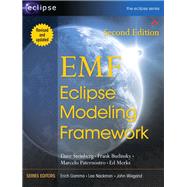
What is included with this book?
Dave Steinberg is a software developer in IBM Software Group. He has worked with Eclipse and modeling technologies since joining the company, and has been a committer on the EMF project since its debut in 2002.
Frank Budinsky, a senior architect in IBM Software Group, is an original coinventor of EMF and a founding member of the EMF project at Eclipse. He is currently cochair of the Service Data Objects (SDO) specification technical committee at OASIS and lead SDO architect for IBM.
Marcelo Paternostro is a software architect and engineer in IBM Software Group. He is an EMF committer and has been an active contributor to several other Eclipse projects. Before joining IBM, Marcelo managed, designed, and implemented numerous projects using Rational's tools and processes.
Ed Merks is the project lead of EMF and a colead of the top-level Modeling project at Eclipse. He holds a Ph.D. in Computing Science and has many years of in-depth experience in the design and implementation of languages, frameworks, and application development environments. Ed works as a software consultant in partnership with itemis AG.
| Front Matter | |
| The Projects | |
| Introducing EMF | |
| Modeling Editing with EMF.Edit | |
| Using EMF--A Simple Overview | |
| Ecore Modeling Concepts | |
| UML | |
| Java Source Code | |
| Extended Ecore Modeling | |
| XML Schema | |
| EMF Generator Patterns | |
| EMF.Edit Generator Patterns | |
| Running the Generators | |
| Example--Implementing a Model and Editor | |
| Metadata | |
| Persistence | |
| EMF Client Programming | |
| The Change Model | |
| The Validation Network | |
| EMF.Edit Programming | |
| Outside of the Eclipse IDE | |
| Table of Contents provided by Publisher. All Rights Reserved. |
The New copy of this book will include any supplemental materials advertised. Please check the title of the book to determine if it should include any access cards, study guides, lab manuals, CDs, etc.
The Used, Rental and eBook copies of this book are not guaranteed to include any supplemental materials. Typically, only the book itself is included. This is true even if the title states it includes any access cards, study guides, lab manuals, CDs, etc.